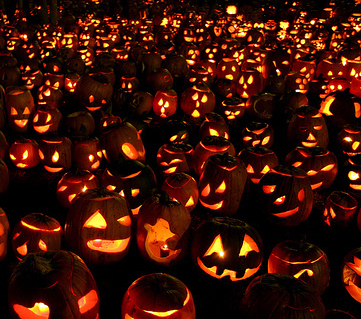I’m a scientist by temperament and by training. For many years, I worked as a biologist in a pharmaceutical company. Our research department had a sister department located in Japan. Because of this partnership, our lab had a series of visiting scientists from Japan. They were always young people, with a spouse and perhaps with a fledgling family, trying to fit into this foreign place. Since science is internationally interwoven, we had visiting scientists from other countries as well: Australia, Brazil, England, France, Spain, Switzerland, Sweden. They would stay here for perhaps two years, and then return to their own labs in their own countries.
Halloween is a traditional American holiday. It can easily appear silly to people from other cultures. They just don’t quite get it. So every Halloween, my housemate and I would invite the visiting scientists and their families to our home to carve pumpkins. We’d also invite a couple of Americans and their children, to create a balance of experience and bafflement. We’d all sit on the floor throughout the house, newspapers spread in front of us, fresh pumpkins at hand with more on the lawn outside, and tea candles ready next to the front door. We’d start to carve our first pumpkin.
You know, if you’ve ever carved a pumpkin, that it can be a gooey mess. If you’re from another culture, like Japan’s, where food and body are kept very clean and very separate from each other, pumpkin carving could appear completely puzzling, intimidating even. But all of our guests politely started, regardless of inner turmoil, watching nearby friends for clues. The experienced carvers would offer witty advice wherever necessary, and generous encouragement to cautious skeptics.
Imagine the surprise and dismay of opening your first pumpkin and looking down into all that pale orange mess, the strings, the seeds, the oddity of it, the slippery randomness of it. Imagine reaching your hand in and feeling the slime and the endlessness of those inner curves. But looking around, others are doing the same thing, talking and laughing, so you bravely move forward, scooping out the seeds, scraping out the strings, cleaning out your hollow. Okay, now what? Draw a face?? A scary face???
The first set of jack o’ lanterns are simple and a bit awkward. Two eyes, a mouth, sometimes with teeth, maybe a nose. As each person finishes his pumpkin, he stands up, carries it to the front door, inserts a tea candle, sets the pumpkin in the garden outside, and lights the candle.
 Night is falling, and slowly the garden fills with jack o’ lanterns. The candles softly glow, brightly, then even more brightly against the darkening backdrop. The Japanese eyes fill with delight. The French man grins and scurries off to get his next pumpkin. The Australian scrutinizes the others’ handiwork and tackles his next globe with blooming creativity. The carved faces become haunted, or lecherous, or jeering. Carved flames leap from mouth corners; carved eyes glower. The jack o’ lanterns are no longer consigned to the lawn; now they’re lurking behind rocks, gaping up from under a bush, cackling down from a tree branch.
Night is falling, and slowly the garden fills with jack o’ lanterns. The candles softly glow, brightly, then even more brightly against the darkening backdrop. The Japanese eyes fill with delight. The French man grins and scurries off to get his next pumpkin. The Australian scrutinizes the others’ handiwork and tackles his next globe with blooming creativity. The carved faces become haunted, or lecherous, or jeering. Carved flames leap from mouth corners; carved eyes glower. The jack o’ lanterns are no longer consigned to the lawn; now they’re lurking behind rocks, gaping up from under a bush, cackling down from a tree branch.
The transformation is complete, for pumpkins and humans alike. We gather with hot apple cider and wander around the garden, delighted. My Finnish friend puts her arm around my shoulder and says delightedly, “Now I understand Halloween. Now I get it.”
So here I am on the spiritual path. I have arrived at the party and understand portions of what I’m encouraged to do. I look around at people I trust and admire, and pay attention to the example they set. I’m learning that the way to learn is to do. I’m delving into my pumpkins, each and every one of them, creating the most magnificent jack o’ lanterns that I can. And I trust that by the time I’m standing in the garden, sipping hot apple cider, watching the glowing faces around me, I will understand why God is expending so much energy to create us, waiting for us to search for Him, and then helping us to find Him.




